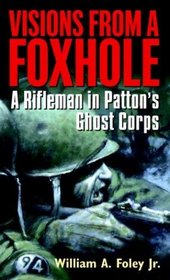Robert S. (radonfish) - , reviewed Visions From a Foxhole : A Rifleman in Patton's Ghost Corps on + 131 more book reviews
Helpful Score: 1
harrowing account, first person, of the 9th divisions bold campaign to break thru hitlers seigfried line at the end of ww11.
After years of reading books on the Civil War and World War II, I, like so many others, understand that the way to really understand what men and women went through is to read personal accounts of individuals at war.
You would think an infantryman who joined an outfit in Europe on 25 January 1945 wouldn't have much to write about. After all, the war only had a few more months to run.
But Private William Foley would see more combat than I could ever imagine. This is a riveting memoir from a soldier who was scared stiff during the first week, when his battalion suffered 60% casualties, and remained scared until the war was over. Yet he proved himself to be an uncommon soldier and was often the point man for his unit. He was also appointed a squad leader while still a private first class.
Foly pulls no punches in his memoirs and tells the good with the bad, his relations with his follow soldiers, allied and German civilians and enemy troops.
I fully admit to being shocked when he writes how, before his unit moved forward after taking a village, his first sergeant told him to take two German POWs outside and shoot them. Foley writes how he took the two men outside and shot them in the back.
Foley was a budding artist and often drew war scenes in black and white on scrounged paper, even while in his foxhole on the front lines. Fortunately, his company commander encouraged him.
After the war, Foley uses the G.I. Bill to study art and became a commercial artist. Eventually, his war time art became a series of murals dedicated to the 94th Infantry Division, in which he served.
His art can also be seen on a Web site today.
I highly recommend this book to all those interested in the daily life of an infantryman in the European Theater.
You would think an infantryman who joined an outfit in Europe on 25 January 1945 wouldn't have much to write about. After all, the war only had a few more months to run.
But Private William Foley would see more combat than I could ever imagine. This is a riveting memoir from a soldier who was scared stiff during the first week, when his battalion suffered 60% casualties, and remained scared until the war was over. Yet he proved himself to be an uncommon soldier and was often the point man for his unit. He was also appointed a squad leader while still a private first class.
Foly pulls no punches in his memoirs and tells the good with the bad, his relations with his follow soldiers, allied and German civilians and enemy troops.
I fully admit to being shocked when he writes how, before his unit moved forward after taking a village, his first sergeant told him to take two German POWs outside and shoot them. Foley writes how he took the two men outside and shot them in the back.
Foley was a budding artist and often drew war scenes in black and white on scrounged paper, even while in his foxhole on the front lines. Fortunately, his company commander encouraged him.
After the war, Foley uses the G.I. Bill to study art and became a commercial artist. Eventually, his war time art became a series of murals dedicated to the 94th Infantry Division, in which he served.
His art can also be seen on a Web site today.
I highly recommend this book to all those interested in the daily life of an infantryman in the European Theater.




